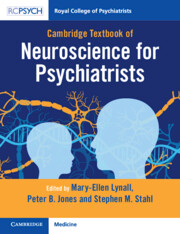Book contents
- Cambridge Textbook Of Neuroscience for Psychiatrists
- Reviews
- Cambridge Textbook of Neuroscience for Psychiatrists
- Copyright page
- Contents
- Contributors
- Introduction
- 1 Cells
- 2 Neurotransmitters and Receptors
- 3 Basic Techniques in Neuroscience
- 4 Neuroanatomy
- 5 Neural Circuits
- 5.1 Appetite
- 5.2 Sleep
- 5.3 Sex and Sex Hormones
- 5.4 Violence and Aggression
- 5.5 Nociception and Pain
- 5.6 The Motor System and Movement Disorders
- 5.7 Computational Models of Learning
- 5.8 Habit Formation
- 5.9 Reward, Pleasure and Motivation
- 5.10 Emotion
- 5.11 Perception
- 5.12 Attention
- 5.13 Apathy, Anhedonia and Fatigue
- 5.14 Memory
- 5.15 Fronto-Executive Functions
- 5.16 Empathy and Theory of Mind
- 5.17 Language
- 5.18 Brain Networks and Dysconnectivity
- 6 Modulators
- 7 Genetics
- 8 Neurodevelopment and Neuroplasticity
- 9 Integrated Neurobiology of Specific Syndromes and Treatments
- 10 Neurodegeneration
- Index
- References
5.8 - Habit Formation
from 5 - Neural Circuits
Published online by Cambridge University Press: 08 November 2023
- Cambridge Textbook Of Neuroscience for Psychiatrists
- Reviews
- Cambridge Textbook of Neuroscience for Psychiatrists
- Copyright page
- Contents
- Contributors
- Introduction
- 1 Cells
- 2 Neurotransmitters and Receptors
- 3 Basic Techniques in Neuroscience
- 4 Neuroanatomy
- 5 Neural Circuits
- 5.1 Appetite
- 5.2 Sleep
- 5.3 Sex and Sex Hormones
- 5.4 Violence and Aggression
- 5.5 Nociception and Pain
- 5.6 The Motor System and Movement Disorders
- 5.7 Computational Models of Learning
- 5.8 Habit Formation
- 5.9 Reward, Pleasure and Motivation
- 5.10 Emotion
- 5.11 Perception
- 5.12 Attention
- 5.13 Apathy, Anhedonia and Fatigue
- 5.14 Memory
- 5.15 Fronto-Executive Functions
- 5.16 Empathy and Theory of Mind
- 5.17 Language
- 5.18 Brain Networks and Dysconnectivity
- 6 Modulators
- 7 Genetics
- 8 Neurodevelopment and Neuroplasticity
- 9 Integrated Neurobiology of Specific Syndromes and Treatments
- 10 Neurodegeneration
- Index
- References
Summary
To understand the most sophisticated human capacities, such as analytical inquiry, social interaction or creativity, it is important to first understand the most basic. This chapter aims to introduce one of the most fundamental brain processes there is – the ability to form habits, to automate the routine and to ignore things that have become predictable. Habits are brilliant in their simplicity and the poetic irony is that we notice least these behaviours that we know the best. If you take one thing away from this chapter, let it be this: without our ability to develop habits, to automate tasks we have performed 100 times or more, our brains would lack capacity to support any of the advanced functions that we prize as humans. At every level of complex thought, habits provide the essential scaffolding. Aside from the fundamental importance of understanding habits for gaining a broader concept of how the brain processes information and arrives at decisions, habits are of extra interest to those in the field of psychiatry. As you will learn, habits play a key role in a range of compulsive disorders, including obsessive–compulsive disorder and addiction.
- Type
- Chapter
- Information
- Cambridge Textbook of Neuroscience for Psychiatrists , pp. 192 - 198Publisher: Cambridge University PressPrint publication year: 2023

